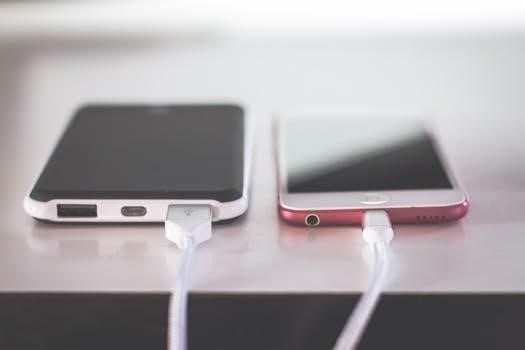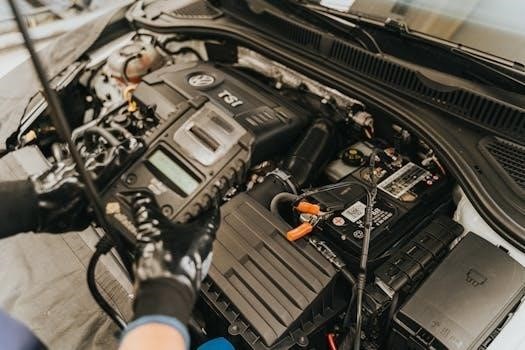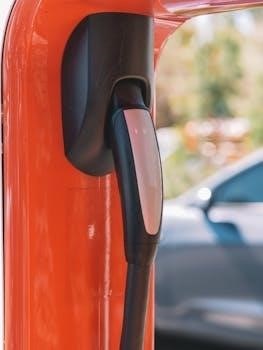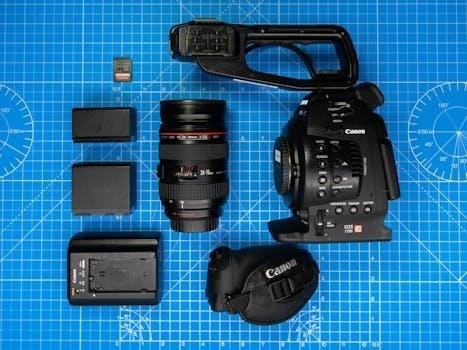battery charger schumacher manual
Summary
Lost your Schumacher battery charger manual? No worries! Find it here and get your car battery charging in no time. Easy downloads!

Schumacher battery chargers come with a crucial manual․ This manual explains how to use the charger safely and effectively․
It is very important to read the instructions and precautions carefully․ This ensures correct use of the battery charger․
Importance of the Owner’s Manual
The owner’s manual for a Schumacher battery charger is an indispensable resource․
It provides critical information on safely and effectively operating the device․ Ignoring the manual can lead to improper use․
Improper use may cause damage to the charger, the battery, or even personal injury․
The manual offers step-by-step instructions․ These instructions cover everything from initial setup to troubleshooting common issues․
It details essential safety precautions․ It helps to prevent electrical shocks, fire hazards, and other potential dangers․
Understanding the charger‘s features and functions is vital․ The owner’s manual ensures that users are well-informed․
Moreover, the manual often includes warranty information․ It includes maintenance guidelines, and specific details related to the charger model․
Consulting the manual before each use is strongly recommended․ The manual helps to maximize the lifespan of the charger and the battery․
It also ensures optimal performance․ Schumacher emphasizes reading the manual․ This is before operating any of their battery chargers․

Safety Instructions
Safety is paramount when using a Schumacher battery charger․ Always read and understand the instructions in the owner’s manual․
Following these guidelines reduces the risk of accidents and ensures safe operation․
Reading and Understanding Safety Warnings
Before operating your Schumacher battery charger, it is extremely important to carefully read and understand all safety warnings․
These warnings are designed to protect you from potential hazards․
The owner’s manual contains vital safety instructions that must be followed․
Ignoring these warnings can result in serious injury or damage to property․
Pay close attention to cautions regarding proper ventilation, avoiding sparks and open flames, and correct battery connections․
Schumacher chargers are powerful tools, and misuse can be dangerous․
Familiarize yourself with all safety symbols and their meanings․
The manual provides detailed explanations of each warning, ensuring you understand the risks involved․
Always disconnect the charger from the power source before inspecting or cleaning it․
Never attempt to charge non-rechargeable batteries․
Always wear safety glasses when working with batteries․
Keep children away from the charging area․
By understanding and adhering to these safety warnings, you can safely and effectively use your Schumacher battery charger․
Regularly review the safety section of the owner’s manual to refresh your knowledge․
Proper Ventilation During Charging
Ensuring proper ventilation during the charging process with your Schumacher battery charger is crucial for safety․
Batteries release flammable gases during charging, which can accumulate and create an explosion hazard․
Always charge your battery in a well-ventilated area, away from enclosed spaces․
The owner’s manual emphasizes the importance of adequate airflow to dissipate these gases․
Avoid charging batteries in garages or sheds without proper ventilation systems․
Open windows and doors to allow fresh air to circulate freely around the charging area․
If you are charging indoors, consider using a fan to improve ventilation․
Never cover the charger or the battery during charging, as this can trap heat and gases․
The manual provides specific guidelines on ventilation requirements based on the charger model․
Regularly check the charging area to ensure that there are no obstructions to airflow․
Proper ventilation minimizes the risk of explosion and ensures a safe charging environment․
Ignoring this precaution can lead to dangerous situations․
Always prioritize safety by following the ventilation instructions in the manual․
Remember, adequate ventilation is a key component of safe battery charging practices with your Schumacher device․
Avoiding Sparks and Open Flames
The Schumacher battery charger manual stresses the critical importance of avoiding sparks and open flames during battery charging․
Batteries emit hydrogen gas, which is highly flammable and can explode if ignited by a spark or flame․
Never smoke or use open flames near a battery being charged․
Ensure the charging area is free from flammable materials, such as gasoline, solvents, or paper․
When connecting or disconnecting the charger, make sure the power is off to prevent sparks․
Double-check all connections to ensure they are secure and free from corrosion, which can cause sparks․
Do not use the charger in areas where flammable vapors may be present․
The manual provides detailed warnings about the risks of sparks and flames in the charging area․
Always exercise caution when working around batteries and charging equipment․
Keep a fire extinguisher nearby in case of an emergency․
Regularly inspect the charger‘s cords and connections for damage that could cause sparks․
If you notice any signs of sparking, immediately disconnect the charger and consult the manual for troubleshooting․
Following these precautions minimizes the risk of fire or explosion during battery charging․
Your safety is paramount, so always adhere to the safety guidelines in the manual․
Remember, preventing sparks and open flames is crucial for safe battery charging․

Operating the Charger
The Schumacher battery charger manual details the proper operation․ This includes connecting to the battery, selecting the correct charging rate, and understanding manual versus automatic modes․
Following these steps ensures safe and effective charging․
Connecting the Charger to the Battery
Before connecting your Schumacher battery charger, always consult the owner’s manual․ The manual provides essential instructions for a safe and effective connection․ First, identify the positive (+) and negative (-) terminals on both the battery and the charger․ Ensure the charger is switched off before making any connections․ Attach the positive (red) clamp to the positive (+) terminal of the battery․ Then, connect the negative (black) clamp to the negative (-) terminal․
Double-check that the connections are secure and free from corrosion․ The manual may recommend cleaning the terminals if necessary․ For vehicle batteries, the negative (-) clamp should be connected to the vehicle chassis away from the fuel line and battery․ This minimizes the risk of sparks igniting flammable gases․ Always refer to your Schumacher battery charger’s manual for specific guidance and safety precautions․ Incorrect connections can damage the charger, the battery, or even cause personal injury, so reading the manual is key!
Selecting the Correct Charging Rate (Amperage)
Choosing the correct charging rate, or amperage, is crucial for effective and safe battery charging․ Your Schumacher battery charger’s owner’s manual provides detailed guidance on this process․ The manual will explain how to determine the appropriate amperage based on the battery’s type, size, and condition․ Typically, a lower amperage is used for slow charging, which is gentler on the battery and extends its lifespan․ Higher amperages are suitable for faster charging but can generate more heat and potentially damage the battery if not carefully monitored․
The manual will also outline the specific amperage settings available on your Schumacher charger․ Some chargers offer automatic settings that adjust the amperage based on the battery’s needs, while others require manual selection․ It’s essential to follow the manual’s recommendations to avoid overcharging or undercharging the battery․ Overcharging can lead to battery damage and reduced performance, while undercharging may not fully replenish the battery’s power․ Always consult your Schumacher battery charger’s manual for optimal charging settings․
Manual vs․ Automatic Operation
Schumacher battery chargers offer both manual and automatic operation modes, each with its own advantages․ The owner’s manual provides a clear explanation of the differences between these modes and how to use them effectively․ Manual operation requires the user to set the charging parameters, such as voltage and amperage, based on the battery’s specifications․ This mode is suitable for experienced users who understand battery charging principles and can monitor the charging process closely․ The manual provides guidance on selecting the appropriate settings and preventing overcharging or undercharging․
Automatic operation, on the other hand, simplifies the charging process by automatically adjusting the charging parameters based on the battery’s condition․ This mode is ideal for users who prefer a hands-off approach and want to avoid the complexities of manual settings․ The charger’s built-in sensors monitor the battery’s voltage and adjust the charging rate accordingly․ The owner’s manual explains how to use the automatic mode and the various safety features that protect the battery from damage․ It’s crucial to consult the manual to understand the specific features and limitations of each mode․

Troubleshooting
The Schumacher battery charger manual provides troubleshooting tips for common issues․ This includes problems like the charger not charging or the battery not accepting a charge․ Consult the manual for solutions․
Charger Not Charging
If your Schumacher battery charger isn’t charging, several factors could be at play, and the manual is your primary resource․
First, ensure the charger is properly connected to a functioning power outlet․ Check the power cord for damage․ A damaged cord needs replacement․ Verify the outlet provides power by testing it with another device․
Next, confirm the charger‘s settings․ Make sure the voltage and amperage settings match the battery requirements․ An incorrect setting will prevent charging․
Inspect the charger‘s fuses․ A blown fuse will halt operation․ Replace any blown fuses with the correct amperage rating as specified in the manual․
If the charger has an automatic shut-off feature, it may have activated․ Disconnect and reconnect the charger to reset it․
Finally, consult the manual for specific error codes or diagnostic procedures․ These will give insights into the problem․ If issues persist, contact Schumacher customer support․
Battery Not Accepting Charge
When a battery refuses to accept a charge from your Schumacher charger, several factors may be responsible, and the manual is key․
First, check the battery‘s condition․ If it’s deeply discharged or sulfated, it might not accept a charge immediately․ Try using a manual charger to provide an initial charge to raise the voltage․
Ensure the battery terminals are clean․ Corrosion can prevent proper contact․ Clean the terminals with a wire brush and baking soda solution, following safety precautions outlined in the manual․
Verify the charger settings are correct for the battery type and voltage․ An incorrect setting may prevent charging or damage the battery․
If using an automatic charger, its internal diagnostics might be preventing the charge․ Disconnect and reconnect to reset․
Consult the manual for troubleshooting steps specific to your charger model․ Some chargers have diagnostic modes․
If problems continue, the battery may be beyond recovery and need replacement․ Always refer to the manual for guidance․

Maintenance and Storage
Proper maintenance and storage of your Schumacher battery charger are essential․ This ensures longevity and reliability․
Refer to your manual for specific instructions․
Regular cleaning and correct storage procedures help․
Cleaning the Charger
Maintaining your Schumacher battery charger involves routine cleaning․ This helps ensure optimal performance and extends the life of the device․
Always disconnect the charger from the power source before cleaning․ This prevents electrical shock and ensures your safety․
Use a dry cloth to wipe down the exterior of the charger․ Avoid using water or any liquid cleaners․ Liquids can damage the internal components․
Pay special attention to the clamps and cables․ Clean any corrosion or debris from the clamps․ Use a wire brush or sandpaper for stubborn buildup․
Check the cables for any signs of damage, such as cracks or fraying․ Replace damaged cables immediately․
Inspect the ventilation slots on the charger․ Remove any dust or obstructions․ This ensures proper airflow and prevents overheating․
Never immerse the charger in water or any other liquid․ This will cause irreparable damage and create a safety hazard․
Store the charger in a clean, dry place after cleaning․ This prevents dust and moisture from accumulating․
Proper Storage Procedures
Proper storage of your Schumacher battery charger is vital for its longevity and performance․ Always disconnect the charger from both the power outlet and the battery before storing it․
Choose a cool, dry location for storage․ Avoid areas with high humidity or extreme temperatures․ Moisture can cause corrosion, and extreme temperatures can damage the internal components․
Wrap the cables neatly to prevent tangling․ Use a cable tie or Velcro strap to secure them․ This keeps the cables organized and prevents damage․
Store the charger in its original packaging if possible․ If not, use a sturdy box or container to protect it from dust and physical damage․
Keep the charger away from flammable materials․ This is a safety precaution to prevent fire hazards․
Regularly inspect the storage area for any signs of moisture or pests․ Address any issues promptly to prevent damage to the charger․
Do not store heavy items on top of the charger․ This can damage the casing and internal components․
By following these storage procedures, you can ensure that your Schumacher battery charger remains in good working condition for years to come․
Warranty Information
Schumacher Electric Corporation warrants its battery chargers against defects in material and workmanship․ The warranty period typically extends for two years from the date of purchase․ This warranty is valid only for the original purchaser and is not transferable․
To make a warranty claim, you must provide proof of purchase, such as a receipt or invoice․ Contact Schumacher Electric’s customer service department to initiate the claim process․ You may be required to return the defective charger for inspection․
The warranty does not cover damage caused by misuse, abuse, neglect, or unauthorized repairs․ It also does not cover normal wear and tear․ The warranty is void if the charger has been tampered with or altered in any way․
Schumacher Electric’s liability under this warranty is limited to the repair or replacement of the defective charger․ Schumacher Electric is not liable for any consequential damages, such as loss of time or inconvenience․
This warranty gives you specific legal rights, and you may also have other rights that vary from state to state․